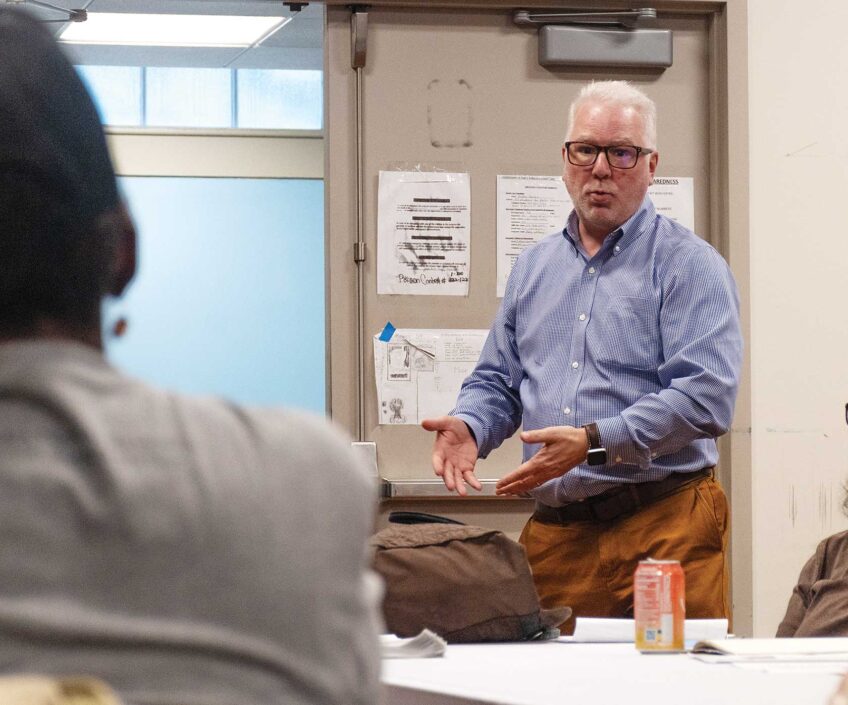School building sell-off?
Emails show BPS, Walsh admin officials planning school closures

City officials, Boston Public School students and parents gathered at the Bruce Bolling Municipal Building in Dudley Square Saturday to weigh in on Build BPS, a facilities master planning process to outline the school department’s building needs over the next ten years.
School Superintendent Tommy Chang told the group that Build BPS would help the department plan for the school system’s future. He and other city officials presented the meeting as an opportunity for parents and students to air their views on the priorities for BPS facilities.
“We want to use Build BPS to imagine the buildings we need for 21st century education,” he said.
But throughout the last year inside City Hall and the Bolling Building, Chang and city officials have been engaged in a different conversation revolving around how to sell the public on a plan to close 30-50 school buildings. That discussion happened behind closed doors, without public deliberation.
Through a Freedom of Information Act request, the parent group Quality Education for Every Student obtained a series of emails on school closures sent by BPS staff, officials in the administration of Mayor Martin Walsh and several outside consultants.
“Framing the Facilities Master Plan as a response to the recommendation to close schools significantly understates the scope and imperative of the plan, but… at the same time, the FMP is the mechanism through which we’ll right-size the district (among accomplishing other things), so not mentioning it would be to create confusion / shadow processes,” wrote Erika Giampietro, a special assistant to Chang in an email to Boston’s Chief of Education Turahn Dorsey that was copied to Margaret Wood, a consultant for the Facilities Master Plan.
Saturday, Dorsey told the Banner that the widely-criticized McKinsey report, which recommended closing as many as 50 school buildings, and the Build BPS process were unrelated.
“We’re going to get the most detailed data ever,” he said of the Build BPS process. “There has not been a comprehensive study of the building portfolio of this scale. We agree with the public that we have to get a better sense of which buildings are overcrowded and how many are under-utilized. The McKinsey report was commissioned to do a snapshot and provide broad-based recommendations.”
But in the emails culled by QUEST, Dorsey and other city and BPS officials exchanged views about how the report could be used to drive BPS policy. In a January 2015 email sent before Chang was hired, Dorsey told David Sweeney, the city’s chief financial officer, the planned McKinsey report could be used to define the next superintendent’s agenda.
“I’ve been talking to one of BPS’ consulting partners, Education Resource Strategies, about an engagement to support the next Superintendent’s transition,” Dorsey wrote. “I would like for the engagement to build on and, where necessary, deepen the McKinsey work, eventually resulting in a 1.0 strategy and implementation plan for the new Superintendent.”
Under the administration of former BPS Superintendent Carole Johnson, the district undertook a facilities assessment that found that 128 BPS school buildings had the capacity for 61,000 students. There are approximately 57,000 students currently enrolled in the system.
Last year, BPS contracted with McKinsey and Company to conduct its assessment of school facilities. The report, a summary of which was released publicly in December, said the BPS school buildings had the capacity to seat 93,000 students, and suggested closing 30 to 50 school buildings. In a November meeting with QUEST members, Walsh reportedly told the parent activists he would like to close as many as 36 schools as part of his 10-year BPS master plan. While Walsh has repeatedly denied making that statement, multiple parent activists say they clearly heard the mayor say it.
QUEST member Megan Wolf said the emails the group obtained provide further proof of the Walsh administration’s plans.
“The e-mails provide a disturbing window on the way City Hall sees the education of our children,” said Wolf in a press statement. “While the Mayor was publically scoffing at parents pointing to his plans to close schools, his own education people were deep in discussion with outside consultants and lobbyists about just such plans. It’s hard to trust any City Hall-led process around school closings after reading these communications.”
In a response to QUEST’s release, emailed to the Banner, Walsh said he has no plans to close schools.
“While I appreciate the input of the McKinsey report, it is only a starting point for analysis, and I have made it clear that I am not comfortable with any proposal that would close schools until we complete our comprehensive facilities master plan,” his statement read.
QUEST originally requested under the Freedom of Information Act copies of emails, phone records and documents about the McKinsey report sent to or by members of the BPS Operational Review Committee. After BPS officials required QUEST to pay $3,000 for the information, the group narrowed the request to emails from Dorsey and BPS Managing Partner of Innovation Ross Wilson. BPS charged them $300 for that request. The group received the emails in May.
Other than Walsh, no elected officials appear in any of the emails. The sole member of the city’s appointed school committee appearing in the emails is the group’s chairman, Michael O’Neil, who received an email from Dorsey suggesting BPS hire Education Resource Strategies, a Watertown-based nonprofit, to help the next superintendent develop a “transformation plan.”
In the emails, city officials repeatedly challenged the idea of making public statements about the selling and leasing of buildings, citing parents’ concerns that BPS buildings would be sold or leased to charter schools that are seeking to expand in Boston and, therefore, capture a greater share of BPS funding.
“I have major concerns about stating ‘sell/lease 30-50 buildings’ as part of a strategy,” wrote the mayor’s Director of External Relations & Opportunity Gap Initiatives Ramon Soto in an email to Dorsey. “It contradicts everything I have been saying about the master planning process: and it will obviously serve to fan the flames regarding the charters and the compact. (see attached) I’m going to touch base with [consultant] Margaret [Wood] and try to re-work the verbiage.”
The release of the emails comes as the Walsh administration’s proposed 2017 BPS budget is drawing sharp criticism from parents and students who argue that the 1.3 percent bump in spending is not keeping pace with rising costs in the school system. The increasing costs are causing a funding shortfall estimated to be $35 million.
While Walsh administration officials say school funding is higher than ever and constitutes a larger share of the city’s budget than any other department, activists note that school funding is the largest share of every municipal budget in Massachusetts and that the 1.3 percent increase in funding for BPS is far lower than the 4 percent increase in overall city spending. At a time when construction of luxury condominiums and new office towers have contributed to a $115 million increase in the city’s tax revenues, activists are questioning why schools are being forced to lay off teachers and shut down advanced placement courses.
Walsh has urged caution on the issue of charter school expansion in Boston, calling for an increase in state reimbursements to district schools as a condition for increasing the number of charter schools in Massachusetts. But the pro-charter Center for the Reinvention of Public Education counts the city as one of 47 in its Portfolio School District network. The CRPE plan calls for districts to close schools and replace them with charters, rein in spending on special education and evaluate teachers based on their students’ test scores.
In one email sent to Chang, Michael Tooke, an investment banker and venture capitalist who is on the steering committee of Boston Leaders for Education, appears to question whether the Walsh administration has the political capital to replace underperforming district schools with charters.
“Does Boston have the political fortitude to rip off the band-aids a) consolidate schools, b) rationalize special education, c) complete central office redesign, and d) improve operations (starting with transportation)?” he writes. “Does Boston have the courage to take an immediate and diverse solution to these underperforming institutions, including closure (in concert with a thoughtful and complete facilities plan), redesign as in-district charters, addition of independent charters or insertion of new school leadership with true autonomy?”
Update
In response to the QUEST release of emails Tuesday, BPS released the following statement:
“There are currently no plans to close any school facilities. While Boston Public Schools appreciates the analysis of external partners and organizations, one evaluation report will not determine the future of our schools. After the completion of the BuildBPS facilities master plan, an informed 10-year road-map will be created to align allocated investments in Boston’s school facilities with the district’s 21st-century educational priorities. We look forward to continued community engagement throughout this process.”







